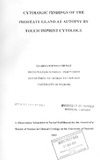| dc.description.abstract | Introduction: Pathological conditions of the prostate include inflammation, prostate
intraepithelial lesions and many types of carcinomas, 95% of which are adenocarcinomas.
The gold standard in diagnosing prostatic carcinoma is trans-rectal ultra sound directedhistological
biopsy. Nevertheless, touch imprint cytology in autopsy diagnosis has been
investigated and found to have good agreement with histology results.
Objective: To describe the cytologic findings of the prostate gland at autopsy by touch
imprint preparations.
Rationale: To demonstrate the use of imprint cytology in the rapid laboratory diagnosis of
neoplasms in autopsy and intra-operative surgical procedures.
Study design: Descriptive cross-sectional study conducted from June to October, 20 IO.
Setting: University of Nairobi cytology laboratory, Kenyatta National Hospital and City
mortuaries.
Sample size: Sixty one prostates excised at autopsy from men aged above 30 years.
Methodology: The glands were weighed and step-sectioned at regular intervals to increase
sample homogeneity. Touch imprints were made from cut surface onto glass slides and fixed
immediately in 95% ethanol and sent to the laboratory for processing using Haematoxylin
and Eosin technique and examined by use of light microscopy. The imprints were screened
and signed out by the two supervisors. Evaluation of cytomorphologic criteria was based on
the microscopic appearance of cellular architecture, cytoplasmic and nuclear features,
staining characteristics and the background milieu. Interpretations were made depending on
the pattern and the degree of cellular atypia. The imprints were then validated by an
independent pathologist blinded to the initial findings for quality control
Outcome measures: Age, weight of gland, benign prostate hyperplasia, prostatitis, prostate
intraepithelial neoplasia and prostatic carcinoma.
Statistical considerations: Statistical comparisons of age groups, weight of glands and the
resultant diagnostic parameters were determined using the Statistical Package for Social
Sciences, version 17. Continuous data (age and weight) was summarized using mean,
median, minimum and maximum. Categorical data (diagnostic outcomes) were presented in frequencies and percentages. Analysis of variance was used to compare the mean differences
on weight of the prostate gland for the various age groups. The t-test was used to make pairwise
comparisons of the two means, to ascertain the groups which are actually different. The
associations of various conditions of the prostate were assessed against age, weight and
statistical conclusions were drawn as to the significance.
Results: The average weight of the 61 prostate glands was 29.6g and the mean age of the
decedents was 50.9 years. Prostatic carcinoma was found in 6.2%, suspicious for malignancy
in 1.6%, Prostatic intraepithelial neoplasia in 8.2%, benign prostate hyperplasia in 8.2%,
prostatitis in 8.2% and corpora amylacea in 13.2% of the study population. Benign prostate
hyperplasia, prostatic intraepithelial neoplasia and prostatic carcinoma were detected at the
age 0[30, 38 and 46 years respectively.
Conclusion: Touch imprint cytology detected malignancy, prostatitis, benign prostate
hyperplasia and other findings that compared well with histological studies. The procedure
will be of future use both in autopsy and in intra-operative procedures as an adjunct to
histology, for rapid detection of tumours In Kenyan district hospitals that lack histology
facilities | en |
| dc.description.department | a
Department of Psychiatry, University of Nairobi, ; bDepartment of Mental Health, School of Medicine,
Moi University, Eldoret, Kenya | |

